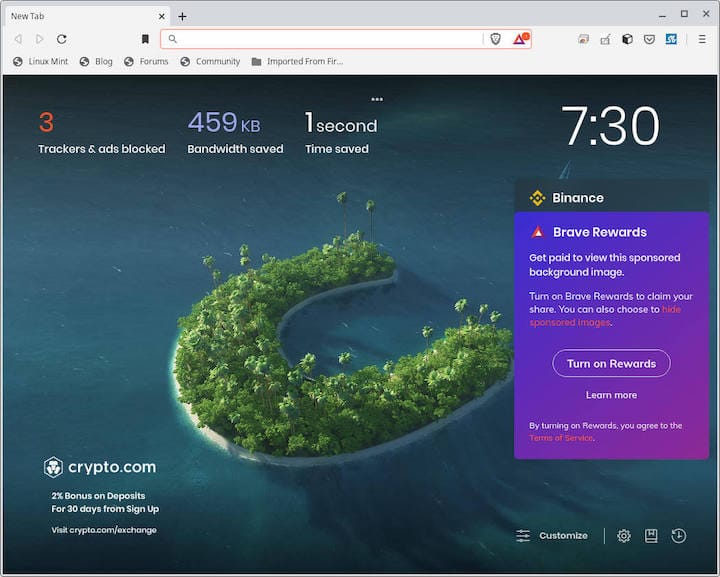How To Install Brave Browser on Debian 12

In this tutorial, we will show you how to install Brave Browser on Debian 12. For those of you who didn’t know, Brave Browser is a fast, open-source web browser that prioritizes user privacy and security. Developed by Brendan Eich and Brian Bondy, the creators of JavaScript and Mozilla Firefox, Brave Browser is built on Chromium, offering a familiar interface while integrating innovative features to enhance your online experience.
Compared to traditional browsers, Brave offers a unique ad-blocking mechanism that not only blocks intrusive ads but also allows users to opt-in to a privacy-respecting ad program to earn rewards in Basic Attention Tokens (BAT). Furthermore, Brave’s integrated Tor browsing mode adds an extra layer of anonymity for sensitive browsing sessions, making it an attractive choice for security-conscious users.
This article assumes you have at least basic knowledge of Linux, know how to use the shell, and most importantly, you host your site on your own VPS. The installation is quite simple and assumes you are running in the root account, if not you may need to add ‘sudo‘ to the commands to get root privileges. I will show you the step-by-step installation of Brave Browser on a Debian 12 (Bookworm).
Prerequisites
- A server running one of the following operating systems: Debian 12 (Bookworm).
- It’s recommended that you use a fresh OS install to prevent any potential issues.
- SSH access to the server (or just open Terminal if you’re on a desktop).
- An active internet connection. You’ll need an internet connection to download the necessary packages and dependencies for Brave Browser.
- A
non-root sudo useror access to theroot user. We recommend acting as anon-root sudo user, however, as you can harm your system if you’re not careful when acting as the root.
Install Brave Browser on Debian 12 Bookworm
Step 1. Before we install any software, it’s important to make sure your system is up to date by running the following apt commands in the terminal:
sudo apt update sudo apt install apt-transport-https curl gnupg
This command will refresh the repository, allowing you to install the latest versions of software packages.
Step 2. Installing Brave Browser on Debian 12.
Now add the Brave repository key to your system by running the following command:
sudo curl -fsSLo /usr/share/keyrings/brave-browser-archive-keyring.gpg https://brave-browser-apt-release.s3.brave.com/brave-browser-archive-keyring.gpg
After adding the key, add the Brave repository to your system by running the following command:
echo "deb [signed-by=/usr/share/keyrings/brave-browser-archive-keyring.gpg] https://brave-browser-apt-release.s3.brave.com/ stable main"|sudo tee /etc/apt/sources.list.d/brave-browser-release.list
Once you have added the Brave repository, update the package list and install the Brave browser by running the following commands:
sudo apt update sudo apt install brave-browser
Step 3. Launch Brave browser on Debian.
After the installation is complete, you can launch the Brave browser from the applications menu or by running the following command in the terminal:
brave-browser

Step 4. Configuring Brave Browser
After successfully installing Brave Browser, it’s time to configure it according to your preferences.
-
Initial Setup:
Upon launching Brave for the first time, you’ll be prompted to customize your settings. Take a moment to personalize the browser according to your preferences, including language, search engine, and more.
- Security and Privacy Settings:
Brave Browser places a strong emphasis on privacy and security. Consider adjusting the following settings to enhance your online protection:
- Shields:
Navigate to brave://settings/shields and fine-tune your browsing experience by controlling ad blocking, tracking prevention, and more.
- Privacy and Security:
Visit brave://settings/privacy to manage site permissions, configure cookie settings, and enable features like the built-in HTTPS Everywhere.
- Extensions and Additional Features:
Extend Brave Browser’s functionality by adding your favorite extensions from the Chrome Web Store. Access the extensions settings at brave://settings/extensions.
Step 5. Uninstalling Brave Browser.
If you ever wish to remove Brave Browser from your Debian 12 system, use the following command:
sudo apt remove brave-browser
To delete any residual configuration files, run:
sudo apt purge brave-browser
Congratulations! You have successfully installed Brave. Thanks for using this tutorial for installing the latest version of Brave Browser on Debian 12 Bookworm. For additional help or useful information, we recommend you check the official Brave website.